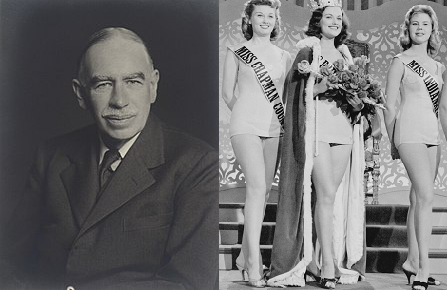I recently bumped into an ex-colleague who used to appear regularly as a guest commentator on financial news TV channels.
I noted that I had not seen him make these guest appearances recently.
He said that he had become fed-up with having to sex-up the price action.
He had also grown irritated at having to make it appear that he always knew the reason for market moves.
On one occasion he said he had a nasty row with one of the news anchors.
The anchor had been pressing him to explain a move that he could not rationalise.
His response to this was to state that ‘the basic explanation was more buyers than sellers‘.
John Maynard Keynes and the Beauty Contest
His sarcastic response to the anchor’s badgering was intended to shut her down.
But it is also represented one of the the oldest truths in financial markets.
It does not matter what the analysis, fundamental news or evidence suggests, it is the weight of buyers and sellers that matter.
One person who understood this perfectly, but only after struggling in the markets for a few years, was John Maynard Keynes.
Keynes realised that markets rarely conform to what appear to be ‘the facts’, but rather it is human emotions that drive markets.
He used the term “animal spirits” to describe how human emotions drives crowd behaviour and markets.
It is the weight of buyers and sellers that matter.
Keynes the Fund Manager
Keynes’ own experiences as an investor were a key factor in helping him come to these conclusions.
He had been responsible for managing the endowment fund of King’s College at Cambridge.
His early experiences as a ‘fund manger’ were less than impressive.
From 1924 to 1932 he only marginally outperformed the under-performing UK stock market.
This was despite Keynes being the most informed person on the planet on the macro-economic factors of the time.
Post-1932 however, Keynes’s investment record was a different story.
The table below is lifted from a 2012 Wall Street article which emphasises this.
Keynes and Value Investing
From 1932 onward, Keynes abandoned his practice of looking at the big macro factors to help determine value.
It was during this time that Keynes became the pioneer of what was to become known as ‘Value Investing‘.
He had come to believe that truth based on objective assessment of data, was less important than trying to understand what ‘moved’ people to value an asset.
If he could understand people’s motivations for valuing an asset, then he could improve how he picks stocks.
Keynes thus adopted a bottom-up ‘value’ approach to stock selection. – He became the world’s first ‘value investor’.
The Keynesian Beauty Contest
To help describe his approach, Keynes came up with the concept of the Keynesian Beauty Contest.
Keynes compared selecting investments to the way people made choices in newspaper beauty contests.
These contests involved Newspapers publishing photos of hundreds of beautiful women.
They would then ask readers to send in their opinions of which women were the most beautiful.
The reader whose choices most closely matched the six most popularly selected women, would win a prize.
Keynes wrote:
“It is not a case of choosing those (faces) which, to the best of one’s judgment, are really the prettiest, nor even those which average opinions genuinely thinks the prettiest. We have reached the third degree where we devote our intelligences to anticipating what average opinion expects the average opinion to be.“
In other words, you could win the context if you could correctly guess what every one else thought, not what you alone thought.
Keynes ‘Beauty Contest’ Concept was in Effect a Mental Model.
Financial markets are complex systems, replete with hidden, unknown and highly variable information.
You can have the greatest brain and best information in the world, but the most important thing is understanding how markets work, then creating models which helps you monetise that.
The early investing experiences of Keynes demonstrated this. In effect, his Keynsian Beauty Contest concept, was really a ‘mental model’ that Keynes had created.
Mental models help one to make sense of the world, they enable us to reduce complexity and filter out noise.
All our perceptions are based on mental models. What we see through our eyes is not an actual representation of reality, but a filtered version.
It is all too easy confuse more knowledge with better knowledge. This is the fallacy which leads many people to think they can predict what will happen next.
Two centuries earlier, another British academic giant, whose status dwarfs even that of Keynes, was to suffer a more dramatic fate.
Isaac Newton having lost almost his entire fortune in the South Sea bubble, is reported to have said, ‘I can calculate the motion of heavenly bodies, but not the madness of people‘.
Cultivating High Performance in Financial Markets:
At Alpha R Cubed, we are passionate about Cultivating High Performance In Financial Markets. We work with Traders and Investors, Leaders and Teams, and whole Organisational Systems from across the spectrum of Financial Market Businesses.
If you are curious about any aspect of our work and would like to enquire about how we could help you or your business, then please email us at info@alpharcubed.com.
If you enjoyed this article:
You may enjoy some of our other articles which explores a range of themes related to Human Performance and Behaviour in Financial Markets



